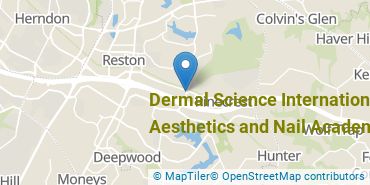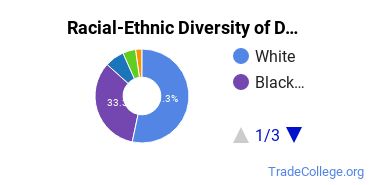Dermal Science International Aesthetics and Nail Academy Trade Programs
Dermal Science International Aesthetics and Nail Academy is a private for-profit institution located in Reston, Virginia. Reston is a great location for students who prefer city over country life.
Featured schools near , edit
Where Is Dermal Science International Aesthetics and Nail Academy?

Contact details for DSI Academy are given below.
| Contact Details | |
|---|---|
| Address: | 11425 Isaac Newton Square, Suite 200, Reston, VA 20190 |
| Phone: | 703-910-2323 |
| Website: | dsiacademy.edu |
Can I Afford DSI Academy?
Student Loan Debt
Almost 66% of college students who graduated with the class of 2018 took out student loans, but that percentage varies from school to school. At DSI Academy, approximately 41% of students took out student loans averaging $5,883 a year. That adds up to $23,532 over four years for those students.
Dermal Science International Aesthetics and Nail Academy Undergraduate Student Diversity

Racial-Ethnic Diversity
The racial-ethnic breakdown of Dermal Science International Aesthetics and Nail Academy students is as follows.

| Race/Ethnicity | Number of Grads |
|---|---|
| Asian | 3 |
| Black or African American | 12 |
| Hispanic or Latino | 13 |
| White | 23 |
| International Students | 0 |
| Other Races/Ethnicities | 1 |
Dermal Science International Aesthetics and Nail Academy Trade School Concentrations
The table below shows the number of awards for each concentration.
| Major | Basic Certificate | TOTAL |
|---|---|---|
| Aesthetician/Esthetician & Skin Care Specialist | 45 | 45 |
| Master Aesthetician/Esthetician | 17 | 17 |
| Permanent Cosmetics/Makeup & Tattooing | 2 | 2 |
| Nail Technician/Specialist & Manicurist | 0 | 0 |
| TOTAL | 64 | 64 |
References
*The racial-ethnic minorities count is calculated by taking the total number of students and subtracting white students, international students, and students whose race/ethnicity was unknown. This number is then divided by the total number of students at the school to obtain the racial-ethnic minorities percentage.
More about our data sources and methodologies.
Featured Schools
 Request Info
Request Info
|
Southern New Hampshire University You have goals. Southern New Hampshire University can help you get there. Whether you need a bachelor's degree to get into a career or want a master's degree to move up in your current career, SNHU has an online program for you. Find your degree from over 200 online programs. Learn More > |
